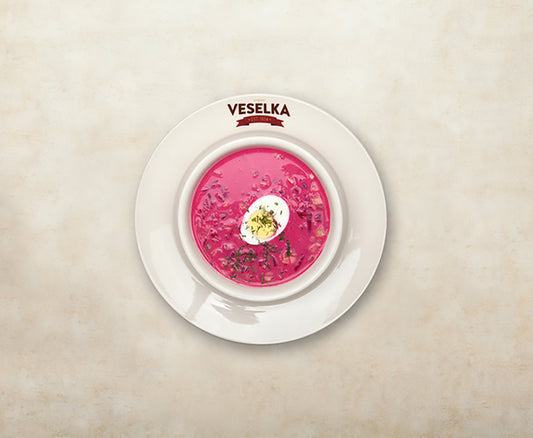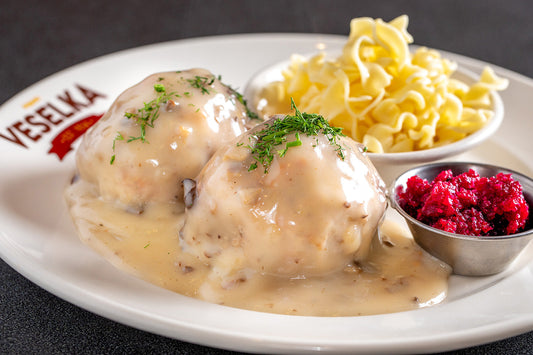Borscht has a story that takes us back centuries and across many borders. Renowned especially in Eastern Europe, with Ukraine at its heart, this beloved beet soup offers a window into the ever-evolving tastes, lifestyles, and histories of the people who have cherished it.
As we explore the history of borscht, we'll look at its beginnings, its cultural impact, and how it has varied across different regions and times. Let's delve into the story of borscht.
Origins of Borscht
The roots of borscht stretch deep into the past, intertwining with the histories of various Eastern European cultures. The meaning of borscht goes beyond just a soup—it's a symbol of tradition, survival, and cultural identity. The name 'borscht' comes from an old Slavic word for 'hogweed', which was the main ingredient in the original recipe. This early version of the soup had a sour taste, as it was made by boiling fermented hogweed stems, leaves, and flowers.
The transformation of borscht began in the 16th century, when Ukrainians, influenced by the Romans, began incorporating beets into the recipe. Beets were not only affordable and nutritious but also added a sweet taste and a vibrant color to the soup. This new version of borscht quickly spread to neighboring regions and eventually became a cornerstone of local cuisine. As borscht traveled across borders and through generations, it absorbed local flavors and ingredients, becoming the diverse and beloved dish known today.
ℹ️ What does borscht taste like?
Cultural Significance and Traditions of Borscht
Delving into the cultural significance and traditions of borscht soup history takes us on a journey through the heart of Eastern European heritage. It's a symbol of home, a bearer of traditions, and a point of pride. Each family often passes down its recipe, each version telling its own story and history.
In Ukraine, where borscht is deeply intertwined with national identity, the soup takes center stage during major celebrations and family gatherings. During Christmas Eve celebrations, borscht takes a prominent place among the 12 traditional Ukrainian dishes.
Beyond festive occasions, borscht is a gesture of hospitality and community. It is featured at various gatherings, and its cultural significance is also evident in regional rituals. For instance, in Podillia, the third day of a wedding is affectionately known as 'do nevistky – na borshch,' which means 'visit the daughter-in-law to eat borscht’. This charming custom underlines borscht's importance in welcoming and honoring new family ties—a sentiment recognized by UNESCO. This rich history of borscht soup reflects the enduring spirit and traditions of Eastern European communities.
Ukrainian Borscht Ingredients
Borscht in Ukraine is a rich mix of different flavors and styles, with each region putting its special touch on this iconic soup. Although recipes differ, they typically use basic, everyday items. Here's a look at the key ingredients from Veselka:
- Red Beets: These give the soup its famous red color and a bit of sweetness.
- Potatoes: They make the soup hearty.
- Cabbage: Adds a fresh and earthy taste.
- Lima Beans: These beans make the soup creamier.
- Celery and Carrot: For extra crunch and a natural sweet flavor.
- Distilled White Vinegar: It balances out the flavors with a little tang.
- Salt and Ground Black Pepper: Basic spices that enhance the overall taste.
- Allspice and Bay Leaf: These add a warm, aromatic touch to the soup.
- Beef Stock: Made with water, beef base, and seasonings. If you're making a vegetarian version, replace this with a hearty vegetable stock.
All these ingredients are mixed to make the classic Ukrainian borscht, loved for its mouthwatering flavors and praised for its health benefits.
ℹ️ Is Borscht Healthy? Exploring The Nutritional Benefits
Varieties of Borscht in Ukraine
In Ukraine, borscht is a collection of regional specialties, each reflecting the distinct flavors and rhythms of the seasons. Let's take a closer look at these diverse dishes:
- Red Borscht: This is the heartwarming beet soup that has made a name for itself far and wide. It's a hearty bowl filled with a wholesome medley of ingredients: pork rump, beef stock combined with a blend of spices and natural flavorings, and a vibrant assortment of vegetables, including red beets, potatoes, cabbage, lima beans, celery, and carrots. This richly flavored soup is perfectly seasoned with distilled white vinegar, salt, ground black pepper, allspice, and bay leaf for an unforgettable taste experience.
- Green Borscht: When spring rolls in, so does green borscht, also known as sorrel soup. It's a lighter fare with zesty young sorrel leaves, potatoes, and a chopped egg, usually finished with a swirl of sour cream.
- Cold Borscht: As summer arrives, borscht takes a refreshing turn. This version is served cold, offering a refreshing respite on hot days, proving that borscht isn't limited to chilly weather.
Each borscht variant reflects Ukraine's expertise in making the most of seasonal ingredients, delivering comfort in a bowl year-round.
FAQs about the History of Borscht
In our FAQs about the history of borscht soup, we discover its origins, evolution, and the many ways it's enjoyed today.
Why is Borscht associated strongly with Ukraine?
Borscht holds a special place in Ukrainian culture and is celebrated as part of its heritage, a fact acknowledged by UNESCO in 2022, according to NPR. The name 'borscht' comes from the Old Slavonic 'borsht', meaning 'hogweed', an ingredient in the soup's earliest recipes. The Ukrainian version of borscht, distinguished by its use of red beetroots, cabbage, potatoes, meat or bone stock, and a variety of other vegetables and seasonings, is particularly renowned. In Ukraine, borscht transcends mere culinary status, symbolizing national pride and identity.
How has Borscht maintained its popularity over the centuries?
Borscht goes way back to the Middle Ages and started as a basic soup, mainly a mix of cow parsnips with meat or chicken broth, egg yolks, and cream. Borscht started simple but grew into many types of tangy soups, each with a special touch from where it's made. It's easy to make, doesn't cost a lot, and you can eat it hot or cold with different extra ingredients on top. This made it popular with lots of people.
Are there any global variations of Borscht outside Eastern Europe?
There are lots of different borscht recipes around the world. For example, in Georgia and Azerbaijan, they might add red chili flakes and sour cherry leaves. In Moldova, you can find borscht with pork, chestnuts, and sauerkraut. In Romania, they sometimes put in sour plums or apricots. In North America, especially in Jewish cooking, borscht often has beets, lemon juice, and sugar, and sometimes eggs or meatballs. This shows how borscht has changed and has been liked by people in many places.
Borscht's Timeless Journey
In the history of borscht, each ingredient carries a story from times long past. This soup, with its origins in Eastern Europe, has lasted through centuries, enriching its flavor and story. At places like Veselka, an Ukrainian restaurant in New York, every spoonful is a reflection of this significant culinary journey. Discover the depth of history in a bowl of borscht from Veselka or experiment with traditional recipes at home. Embark on a culinary journey through time with this iconic dish.





